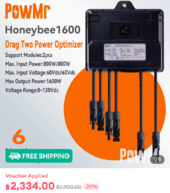So as the forum is slowly but surely feeding my OCD I'm begining to come up with a plan for my solar project at the end of the year. The finer details I can cover closer to install but deciding the big ticket items is my focus at the moment.
First and foremost is the inverter, I was looking at the Deye SUN-5K-SG05LP-EU at first as this is on the approved list of on-grid inverters for Thailand but after reading posts and multiple comments I've seen by @SeaGal I looked at Solis and the S6-EH1P6K-L-PLUS took my eye this is also on the approved list.
Thailand has a max grid feed of 5kw so many of the higher KW models don't meet their approved list and the fact the Solis is 6kw would give me a tad more headroom, so here's my first question I'll likely only use 1 mppt on either inverter at first and stick to off-grid then get the system approved after installation then I can add the 2nd string at a later date to feed into the grid once the application goes through can I effectively use them off-grid/hybrid to begin with? can anyone see any issues with either of these inverters? The Solis offers more connectivity without having to pay and it's a few $100 cheaper but then there's battery support.
My original idea was to build my own batteries but I've seen reports that the warranty wouldn't apply if DIY batteries are involved, I only have a few thousand to spend on storage so I wanted the most bang for my buck as I possibly could preferably sticking to the Thai market as they're cheaper than ali for DIY or pre built as far as I can see I'll need to go through the supported lists and not only chose based on price but also cooling solutions.
Now last part is the panels I get the gist of sizing voc, amperage and so on but I'm thrown by bifacial panels, with such a low declination will I see any benefit from them? Is there any downside to them? Current plan is to fabricate mobile ground mounts as we still haven't decided where the best place to mount them will be on the farm/forest. I saw wills video last week about his new favourite panels and noted what he said about them working better raised but we don't get snow and the ground is mainly red clay so apart from heat I don't see much being reflected.
Thanks in advance.
First and foremost is the inverter, I was looking at the Deye SUN-5K-SG05LP-EU at first as this is on the approved list of on-grid inverters for Thailand but after reading posts and multiple comments I've seen by @SeaGal I looked at Solis and the S6-EH1P6K-L-PLUS took my eye this is also on the approved list.
Thailand has a max grid feed of 5kw so many of the higher KW models don't meet their approved list and the fact the Solis is 6kw would give me a tad more headroom, so here's my first question I'll likely only use 1 mppt on either inverter at first and stick to off-grid then get the system approved after installation then I can add the 2nd string at a later date to feed into the grid once the application goes through can I effectively use them off-grid/hybrid to begin with? can anyone see any issues with either of these inverters? The Solis offers more connectivity without having to pay and it's a few $100 cheaper but then there's battery support.
My original idea was to build my own batteries but I've seen reports that the warranty wouldn't apply if DIY batteries are involved, I only have a few thousand to spend on storage so I wanted the most bang for my buck as I possibly could preferably sticking to the Thai market as they're cheaper than ali for DIY or pre built as far as I can see I'll need to go through the supported lists and not only chose based on price but also cooling solutions.
Now last part is the panels I get the gist of sizing voc, amperage and so on but I'm thrown by bifacial panels, with such a low declination will I see any benefit from them? Is there any downside to them? Current plan is to fabricate mobile ground mounts as we still haven't decided where the best place to mount them will be on the farm/forest. I saw wills video last week about his new favourite panels and noted what he said about them working better raised but we don't get snow and the ground is mainly red clay so apart from heat I don't see much being reflected.
Thanks in advance.






